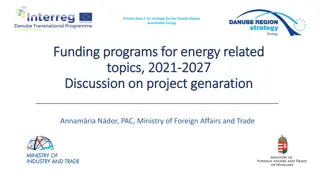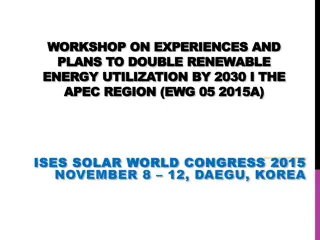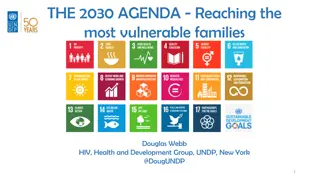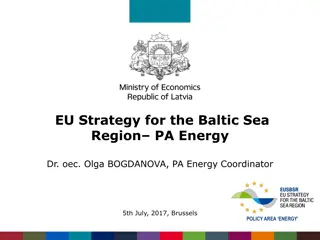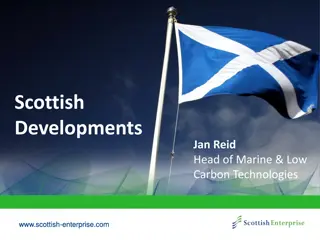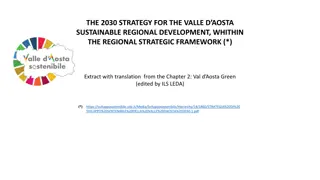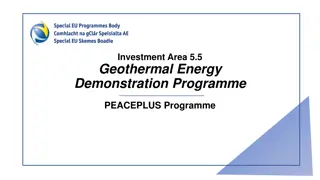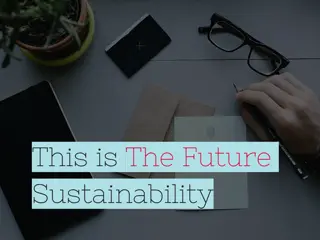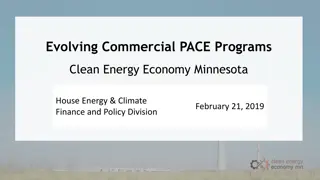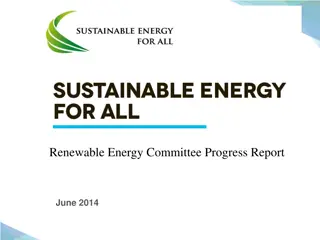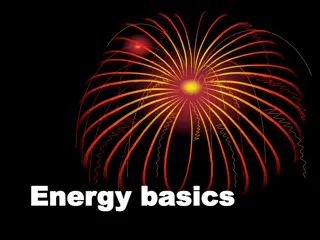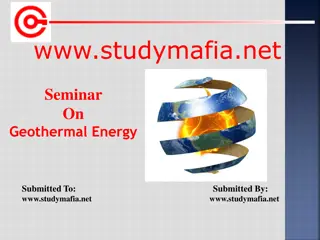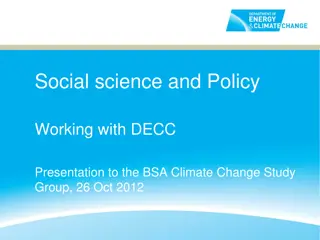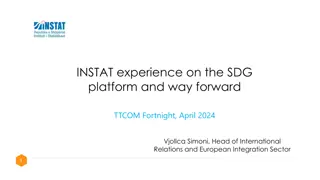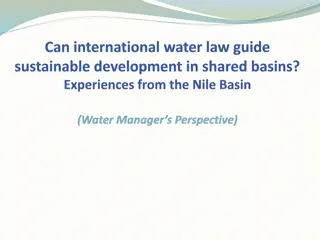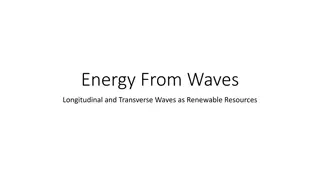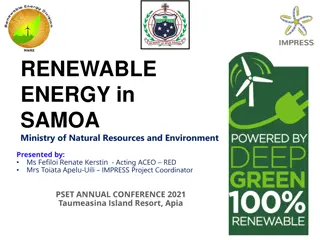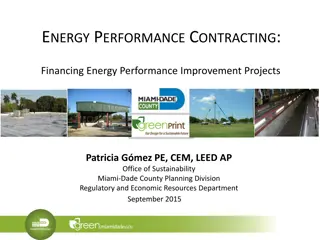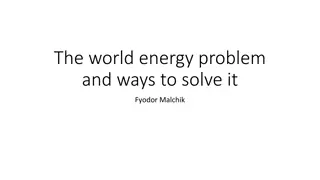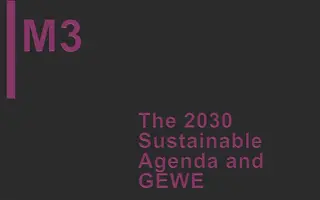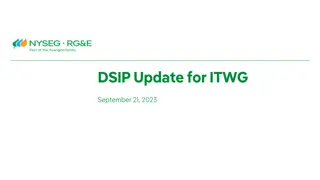Exploring Finland's Sustainable Energy Policy Agenda: 2024-2030
Finnish energy sector aims for a sustainable future with decreased CO2 emissions, increased reliance on renewables, and customer empowerment. Transitioning away from district heating emissions, the goal is a carbon-neutral energy landscape by 2035. The policy emphasizes security, affordability, and cleanliness in energy production, aligning with global trends in energy transition strategies and investments.
Download Presentation

Please find below an Image/Link to download the presentation.
The content on the website is provided AS IS for your information and personal use only. It may not be sold, licensed, or shared on other websites without obtaining consent from the author. Download presentation by click this link. If you encounter any issues during the download, it is possible that the publisher has removed the file from their server.
E N D
Presentation Transcript
Policy architecture for a sustainable energy system Finnish Energy input to energy policy agenda of 2024-29
Vision of the Finnish Energy sector Energy sector has a net positive impact on biodiversity. Services of the new energy system empower the customers. In 2035 customers, society and the environment will gain new wellbeing from carbon- neutral energy Energy investments are funded by the market, utilise new technology and deliver prosperity in a cost-effective way. Secure energy is making Finland attractive for investment.
What is needed to continue this trend of CO2 emissions If it can be done in Finnish conditions, it can be done in Finland is an energy intensive country Europe! Emissions from energy production in Finland have declined 74% from the peak of 2003 Primary energy consumption (per capita per year) 68 35 MWh MWh Electricity consumption (per capita per year) 16 7 MWh MWh
Emissions of district heating in Finland will likely be phased out by 2030 History of district heating emissions Future of district heating emissions Estimate based on the plans of the Finnish district heating companies 116 37 12 2028 2021 2022 2023 2024 2025 2026 2027 2029 2030
What do we want from energy policy But getting these all three requires balanced energy policy Having to pick only two would be a failure of policy We certainly cannot pick just one Secure Secure Secure Cheap Cheap Clean Clean Cheap Clean
Legacy of the term 2019-24 Green deal, FF55, RePowerEU 2024-29 How the world has changed Pandemic, strategic rivalry, war, biodiversity How can we streamline policies, cater for strategic autonomy and ensure wellbeing and competetiveness of Europe What is the stage of energy transition Cost of renewables, flexibility, hydrogen, industry, grids Mobilising investment by streamlining regulation What is politically feasible Polarisation, the economy, prices
Ideas for the 2024-29 term The 2040 climate target, halting biodiversity loss and well- functioning markets require clarity on energy policy Mobilising investment by streamlining regulation Zero-emission economy Environment and energy together Well-functioning electricity markets Strong infrastructure Emissions from electricity and heat to be reduced by developing emissions trading Streamlined environmental permitting Strengthen the incentives to invest in power grids A route out of emergency politics Energy efficiency regulation compatible with the internal market Reconciling green transition projects with environmental sustainability Developing financial regulation of the energy sector Ensure the availability of an alternative heating infrastructure Common sustainability indicators, taking value chains into account Fitness check of the rules governing energy communities and small-scale production Targeting emissions when regulating hydrogen and electrification
Well-functioning electricity markets A route out of the crisis-era Removal of price regulation Promoting free competition and a functioning market by removing excessive detail in regulation Eliminate or at least open up to competition state aid that restricts and discourages market-driven investment Launch a study on the development of a common European electricity market model to ensure the adequacy of electricity supply Fitness check for communities and small production rules Energy communities and small-scale production are the future and the future must be fair, with clear and fair rules of the game The rules of the game for communities and small- scale generation require a fitness check - at present, regulation is fragmented into different provisions and creates a multitude of different legal frameworks for operating (CEC, REC, active customers, energy sharing, ...) Dismantling cross-subsidies - all users participate on a level playing field in network costs and the energy system Developing financial regulation targeted at the sector Understanding the importance of financial markets and their regulation and identifying the needs of the energy sector, removing unnecessary regulation of the sector
Strong infrastructure Strengthening the conditions for network investment Alternative heating infrastructure available to people Enabling proactive and planned network development Ensuring incentives to accelerate the pace of investment, both in terms of network reinforcement and renewal, digitalisation and increased flexibility, including anticipatory investments. Setting a target for alternative heating infrastructure Member States must ensure that customers have access to an alternative heating infrastructure (electricity or district heating). Enabling the development of networks as a whole in a cost- effective way By taking into account the OPEX - CAPEX balance. Ensuring that the network company has a wide range of tools at its disposal to develop networks in a cost-effective way. Regulation does not choose the means, but sets the targets. Simplifying the fragmented regulation of energy use and heating in buildings and focusing on guiding targets The regulation of energy use and heating in buildings should form a coherent whole, guided by targets rather than individual measures. Reduce the demands on administrations and public authorities from the various directives. Regulation of energy efficiency in construction should focus on technology-neutral elements, such as emissions and flexibility. Regulation should not address the energy sources used by buildings. Nor does it discriminate against grid energy in other ways, but aims at cost- effectiveness Reducing the political risk associated with investments Ensuring the independence of public authorities Using bottleneck revenues to finance network investments Targeting funding to reduce bottlenecks between revenue- generating regions Clarifying the roles and responsibilities of commercial and monopoly operators
Clean economy Making energyefficiency regulation compatible with the internal market Bringing down climate emissions from electricity and heat by developing an emissions trading scheme Energy efficiency policy measures must support the achievement of the climate target. Total EU emissions should be reduced by 80-90% from 1990 levels by 2040. The 2040 framework should be built in particular on emissions trading. Energy efficiency regulation should be simplified and focused to support the EU's transition away from fossil fuels. Instead of limiting consumption, energy efficiency targets should promote emission reductions and take into account the technologies needed for a clean transition on a Member State-by-Member State basis. Further development of emissions trading and the re-setting of the 2040 emissions quota is needed to ensure continued emission reductions in the energy sector in a reliable and cost-effective way. Emissions in the focus when adjustingthe rules for electrification Emissions trading should cover a larger share of EU emissions, possibly even all of them. In particular for heating, coverage must be ensured. The rules of the game for hydrogen and electrification should be simplified and focused on accelerating overall emission reductions, with the EU's electricity generation emission reductions already secured by the emissions trading quota. All forms of zero-emission and carbon-neutral production must be available for investors Ensuring the interoperability of hydrogen and electrical infrastructure. Developing the competitiveness of nuclear, hydro, bioenergy, clean gases, wind and solar power
Environment and energy together Reconciling green transition projects and ecological sustainability Addressing climate change, biodiversity loss, the circular economy and zero pollution together - focusing on overall sustainability Review of the extension of the WFD when the current target date of 2027 is reached, the feasibility of exemptions and flexibilities for renewable energy/green transition projects Provide for streamlined environmental permitting Bringing together authorisation legislation scattered across different regulations (RED, NZIA, CRM, IED) under a single European procedural directive/regulation Centralised regulation of binding deadlines and the one-stop-shop principle Moving towards the principle of 1 complaint per project Setting a requirement for predictability Common sustainability indicators taking into account value chains Developing harmonised EU-level indicators for assessing nature impacts Fitness check for wide usability and acceptability of various footprint and life cycle assessments (e.g. by donors, legislation, outside the EU)









